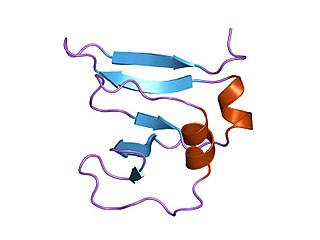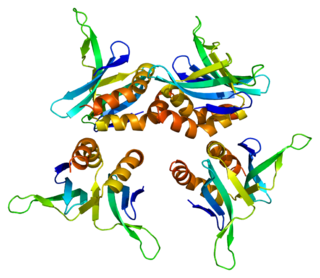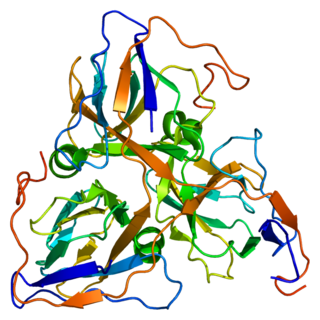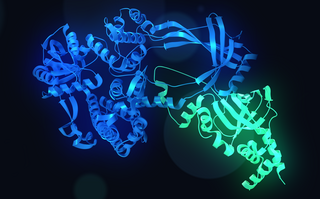DNA topoisomerase 2-beta is an enzyme that in humans is encoded by the TOP2B gene. [5] [6]
DNA topoisomerase 2-beta is an enzyme that in humans is encoded by the TOP2B gene. [5] [6]
This gene encodes a DNA topoisomerase, an enzyme that controls and alters the topologic states of DNA during transcription. This nuclear enzyme is involved in processes such as chromosome condensation, chromatid separation, and the relief of torsional stress that occurs during DNA transcription and replication. It catalyzes the transient breaking and rejoining of two strands of duplex DNA which allows the strands to pass through one another, thus altering the topology of DNA. Two forms of this enzyme exist as likely products of a gene duplication event. The gene encoding this form, beta, is localized to chromosome 3 and the alpha form is localized to chromosome 17. The gene encoding this enzyme functions as the target for several anticancer agents, for example mitoxantrone, and a variety of mutations in this gene have been associated with the development of drug resistance. Reduced activity of this enzyme may also play a role in ataxia-telangiectasia. Alternative splicing of this gene results in two transcript variants; however, the second variant has not yet been fully described. [7]
During a new learning experience, a set of genes is rapidly expressed in the brain. This induced gene expression is considered to be essential for processing the information being learned. Such genes are referred to as immediate early genes (IEGs). TOP2B activity is essential for the expression of IEGs in a type of learning experience in mice termed associative fear memory. [8] Such a learning experience appears to rapidly trigger TOP2B to induce double-strand breaks in the promoter DNA of IEG genes that function in neuroplasticity. Repair of these induced breaks is associated with DNA demethylation of IEG gene promoters allowing immediate expression of these IEG genes. [8]
Activation of more than 600 regulatory sequences in promoters and 800 regulatory sequences in enhancers, in many cell types, appears to depend on short-term double-strand breaks initiated by TOP2B. [9] [10] The induction of particular double-strand breaks are specific with respect to their inducing signal. When neurons are activated in vitro, just 22 of TOP2B-induced double-strand breaks occur in their genomes, largely at immediate early genes. [11]

The induction of short-term double-strand breaks by TOP2B occurs in association with at least four enzymes of the non-homologous end joining (NHEJ) DNA repair pathway (DNA-PKcs, KU70, KU80 and DNA LIGASE IV) (see Figure). These enzymes repair the double-strand breaks within about 15 minutes to two hours. [11] [12] The double-strand breaks in the promoter are thus associated with TOP2B and at least these four repair enzymes. These proteins are present simultaneously on a single promoter nucleosome (there are about 147 nucleotides in the DNA sequence wrapped around a single nucleosome) located near the transcription start site of their target gene. [12]
The double-strand break introduced by TOP2B apparently frees a part of the promoter at an RNA polymerase-bound transcription start site to physically move to its associated enhancer (see regulatory sequence). This allows the enhancer, with its bound transcription factors and mediator proteins, to directly interact with the RNA polymerase paused at the transcription start site to start transcription. [11] [13]

Contextual fear conditioning in the mouse causes the mouse to have a long-term memory and fear of the location in which it occurred. This conditioning causes hundreds of gene-associated DSBs in the medial prefrontal cortex (mPFC) and hippocampus that are important for learning and memory. [14]
Interactions of TOP2B and DNA also regulate transcription of genes that are important for development. These include genes encoding axon guidance factors and cell adhesion molecules. Specifically, TOP2B is required for lamina-specific targeting of retinal ganglion cell axons and dendrites in the zebrafish. [15]
TOP2B has been shown to interact with:
In Drosophila Hadlaczky et al 1988 found DNA topoisomerase II β did not correlate with cell proliferation - while α did. [22]

Transcription is the process of copying a segment of DNA into RNA. The segments of DNA transcribed into RNA molecules that can encode proteins are said to produce messenger RNA (mRNA). Other segments of DNA are copied into RNA molecules called non-coding RNAs (ncRNAs). mRNA comprises only 1–3% of total RNA samples. Less than 2% of the human genome can be transcribed into mRNA, while at least 80% of mammalian genomic DNA can be actively transcribed, with the majority of this 80% considered to be ncRNA.
DNA topoisomerases are enzymes that catalyze changes in the topological state of DNA, interconverting relaxed and supercoiled forms, linked (catenated) and unlinked species, and knotted and unknotted DNA. Topological issues in DNA arise due to the intertwined nature of its double-helical structure, which, for example, can lead to overwinding of the DNA duplex during DNA replication and transcription. If left unchanged, this torsion would eventually stop the DNA or RNA polymerases involved in these processes from continuing along the DNA helix. A second topological challenge results from the linking or tangling of DNA during replication. Left unresolved, links between replicated DNA will impede cell division. The DNA topoisomerases prevent and correct these types of topological problems. They do this by binding to DNA and cutting the sugar-phosphate backbone of either one or both of the DNA strands. This transient break allows the DNA to be untangled or unwound, and, at the end of these processes, the DNA backbone is resealed. Since the overall chemical composition and connectivity of the DNA do not change, the DNA substrate and product are chemical isomers, differing only in their topology.
A regulatory sequence is a segment of a nucleic acid molecule which is capable of increasing or decreasing the expression of specific genes within an organism. Regulation of gene expression is an essential feature of all living organisms and viruses.

RNA polymerase II is a multiprotein complex that transcribes DNA into precursors of messenger RNA (mRNA) and most small nuclear RNA (snRNA) and microRNA. It is one of the three RNAP enzymes found in the nucleus of eukaryotic cells. A 550 kDa complex of 12 subunits, RNAP II is the most studied type of RNA polymerase. A wide range of transcription factors are required for it to bind to upstream gene promoters and begin transcription.

In molecular biology Type I topoisomerases are enzymes that cut one of the two strands of double-stranded DNA, relax the strand, and reanneal the strand. They are further subdivided into two structurally and mechanistically distinct topoisomerases: type IA and type IB.

Type II topoisomerases are topoisomerases that cut both strands of the DNA helix simultaneously in order to manage DNA tangles and supercoils. They use the hydrolysis of ATP, unlike Type I topoisomerase. In this process, these enzymes change the linking number of circular DNA by ±2. Topoisomerases are ubiquitous enzymes, found in all living organisms.

DNA topoisomerase IIα is a human enzyme encoded by the TOP2A gene.

DNA topoisomerase 1 is an enzyme that in humans is encoded by the TOP1 gene. It is a DNA topoisomerase, an enzyme that catalyzes the transient breaking and rejoining of a single strand of DNA.

Calcium/calmodulin-dependent protein kinase type IV is an enzyme that in humans is encoded by the CAMK4 gene.

Beta-galactoside alpha-2,6-sialyltransferase 1 is an enzyme that in humans is encoded by the ST6GAL1 gene.

Flap endonuclease 1 is an enzyme that in humans is encoded by the FEN1 gene.

Calcium/calmodulin-dependent protein kinase type 1 is an enzyme that in humans is encoded by the CAMK1 gene.

Activated RNA polymerase II transcriptional coactivator p15 also known as positive cofactor 4 (PC4) or SUB1 homolog is a protein that in humans is encoded by the SUB1 gene. The human SUB1 gene is named after an orthologous gene in yeast.

Tyrosyl-DNA phosphodiesterase 1 is an enzyme that in humans is encoded by the TDP1 gene.

DUTP pyrophosphatase, also known as DUT, is an enzyme which in humans is encoded by the DUT gene on chromosome 15.

DNA topoisomerase 3-alpha is an enzyme that in humans is encoded by the TOP3A gene.

Beta-1,4-mannosyl-glycoprotein 4-beta-N-acetylglucosaminyltransferase is an enzyme that in humans is encoded by the MGAT3 gene.

DNA topoisomerase 3-beta-1 is an enzyme that in humans is encoded by the TOP3B gene.

General transcription factor IIE subunit 2 (GTF2E2), also known as transcription initiation factor IIE subunit beta (TFIIE-beta), is a protein that in humans is encoded by the GTF2E2 gene.
While the cellular and molecular mechanisms of learning and memory have long been a central focus of neuroscience, it is only in recent years that attention has turned to the epigenetic mechanisms behind the dynamic changes in gene transcription responsible for memory formation and maintenance. Epigenetic gene regulation often involves the physical marking of DNA or associated proteins to cause or allow long-lasting changes in gene activity. Epigenetic mechanisms such as DNA methylation and histone modifications have been shown to play an important role in learning and memory.